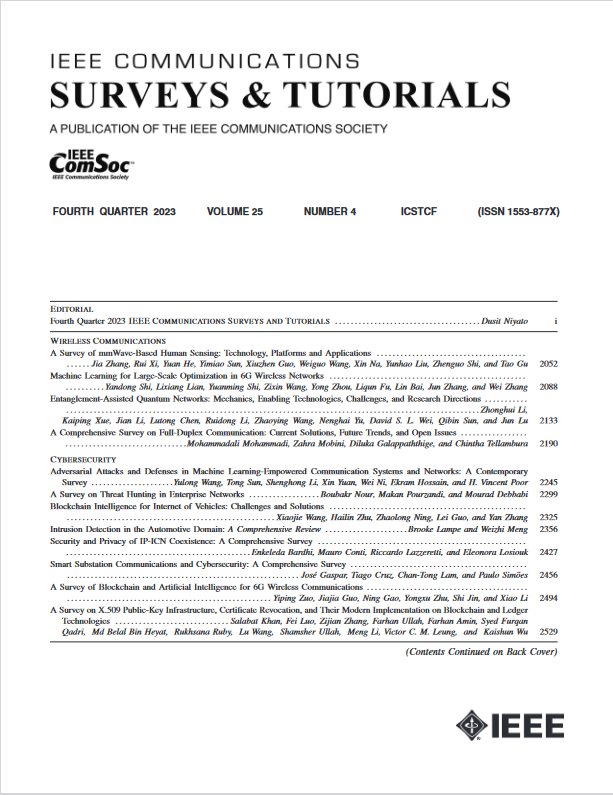Resource Management in RIS-Assisted Rate Splitting Multiple Access for Next Generation (xG) Wireless Communications: Models, State-of-the-Art, and Future Directions
IF 34.4
1区 计算机科学
Q1 COMPUTER SCIENCE, INFORMATION SYSTEMS
引用次数: 0
Abstract
Next Generation (xG) wireless networks require more stringent performance levels. New technologies such as Reconfigurable Intelligent Surfaces (RISs) and Rate Splitting Multiple Access (RSMA) are candidates for meeting some of the performance requirements, including higher user rates at reduced costs. RSMA provides a new way of mixing the messages of multiple users, and the RIS provides a controllable wireless environment. This paper provides a comprehensive survey on the various aspects of the synergy between RISs and RSMA for xG wireless communications systems. In particular, the paper studies more than 60 articles considering over 20 different system models where the RIS-aided RSMA system shows performance advantage (in terms of sum-rate or outage probability) over traditional RSMA models. These models include reflective RIS, Simultaneously Transmitting and Reflecting (STAR)-RIS, as well as transmissive surfaces. The state-of-the-art resource management methods for RIS-assisted RSMA communications employ traditional optimization techniques and/or machine learning techniques. We outline major research challenges and multiple future research directions.下一代 (xG) 无线通信中 RIS 辅助速率分裂多路存取的资源管理:模型、技术现状和未来方向
下一代(xG)无线网络需要更严格的性能要求。可重构智能表面(RISs)和速率分割多址(RSMA)等新技术是满足某些性能要求的候选技术,包括以更低的成本提高用户速率。RSMA提供了一种混合多用户消息的新方法,RIS提供了一个可控的无线环境。本文对xG无线通信系统中RISs和RSMA之间协同作用的各个方面进行了全面的调查。特别是,本文研究了60多篇文章,考虑了20多种不同的系统模型,其中ris辅助RSMA系统比传统的RSMA模型显示出性能优势(在求和率或中断概率方面)。这些模型包括反射式RIS,同时发射和反射(STAR)-RIS,以及透射表面。ris辅助RSMA通信的最先进的资源管理方法采用传统的优化技术和/或机器学习技术。我们概述了主要的研究挑战和未来的多个研究方向。
本文章由计算机程序翻译,如有差异,请以英文原文为准。
求助全文
约1分钟内获得全文
求助全文
来源期刊

IEEE Communications Surveys and Tutorials
COMPUTER SCIENCE, INFORMATION SYSTEMS-TELECOMMUNICATIONS
CiteScore
80.20
自引率
2.50%
发文量
84
审稿时长
6 months
期刊介绍:
IEEE Communications Surveys & Tutorials is an online journal published by the IEEE Communications Society for tutorials and surveys covering all aspects of the communications field. Telecommunications technology is progressing at a rapid pace, and the IEEE Communications Society is committed to providing researchers and other professionals the information and tools to stay abreast. IEEE Communications Surveys and Tutorials focuses on integrating and adding understanding to the existing literature on communications, putting results in context. Whether searching for in-depth information about a familiar area or an introduction into a new area, IEEE Communications Surveys & Tutorials aims to be the premier source of peer-reviewed, comprehensive tutorials and surveys, and pointers to further sources. IEEE Communications Surveys & Tutorials publishes only articles exclusively written for IEEE Communications Surveys & Tutorials and go through a rigorous review process before their publication in the quarterly issues.
A tutorial article in the IEEE Communications Surveys & Tutorials should be designed to help the reader to become familiar with and learn something specific about a chosen topic. In contrast, the term survey, as applied here, is defined to mean a survey of the literature. A survey article in IEEE Communications Surveys & Tutorials should provide a comprehensive review of developments in a selected area, covering its development from its inception to its current state and beyond, and illustrating its development through liberal citations from the literature. Both tutorials and surveys should be tutorial in nature and should be written in a style comprehensible to readers outside the specialty of the article.
 求助内容:
求助内容: 应助结果提醒方式:
应助结果提醒方式:


